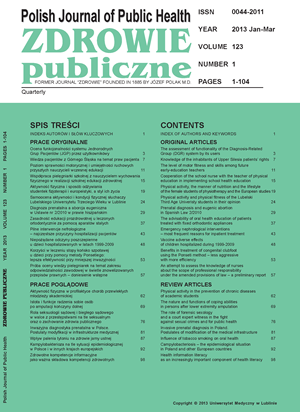Physical activity, the manner of nutrition and the lifestyle of the female students of physiotherapy and the European studies
DOI:
https://doi.org/10.12923/j.0044-2011/123-1/a.05Keywords:
health, lifestyle, physical activity, nourishmentAbstract
Introduction. Our health depends on our lifestyle in almost 60%, while genetic and environmental factors are of minor importance. Lack of physical activity, the use of stimulants and inappropriately balanced diet are the causes of substantial reduction of fitness and psychological efficiency. Such a lifestyle might have adverse influence on our health and bring serious consequences in later years.
Aim. The aim of the study was to evaluate the level of knowledge and the health behaviours concerning physical activity, the nutrition, stimulants intake and the use of reduction diets by the female students of master’s degree course of The Faculty of Physiotherapy of The University of Physical Education in Wrocław and the European Studies of The University of Wrocław.
Material and methods. Thirty healthy female students of physiotherapy and thirty female students of the European studies participated in the present study. The study was performed by the use of questionnaire, which was fulfilled anonymously by the participants and consisted of 60 closed and semi-closed questions.
Results. The present analysis of the health behaviours shows that most of the female students (90%) practise some kind of physical activity. The main reasons for that are benefits for health and care for the outlook. Only 40% of respondents eat meals regularly, whereas 73% and 63% of female students of physiotherapy and female students of the European Studies, respectively, do not eat breakfasts at all. In addition, 75% of all these students do not smoke cigarettes and 51% use a reduction diet.
Conclusions. The present results show that despite the irregularity of lifestyle, all these students try to bring health behaviours in their life. It is noteworthy that the lifestyle of female students of physiotherapy is on a very high level. They set a good example, showing a high level of physical activity, avoiding the use of stimulants and eating high-value meals
References
1. Drabik J. Aktywność, sprawność i wydolność fizyczna jako miernik zdrowia człowieka. Gdańsk: AWF; 1997. p. 23-6.
2. Maciantowicz J, Nowak P. Bieganie, sposób na zdrowe życie. Wrocław: AWF; 2002. p. 34-6.
3. Ostrowska A. Styl życia a zdrowie. Warszawa: IPiS PAN; 1999. p. 13-21.
4. Żukowska Z, Żukowski R. Zdrowie – Ruch – Fair play. Warszawa: AWF; 2001. p. 73-9.
5. Malara B, Góra-Kupilas K, Jośko J. Odżywianie się i inne elementy stylu życia studentów Politechniki Śląskiej – doniesienia wstępne. Zdr Publ. 2006;116(1):131-4.
6. Zarzecka-Baran M, Wojdak-Hassa E. Wiedza studentów Akademii Me¬dycznej w Gdańsku o niektórych elementach stylu życia. Probl Hig Epi¬demiol. 2007;88(1):55-9.
7. Ruszkowska-Majzel J, Drygas W. Skuteczne metody promowania aktyw-nego trybu życia, jako wyzwanie dla światowych działań z dziedziny zdrowia publicznego. Zdr Publ. 2007;117(2):225-31.
8. Krzych Ł. Analiza stylu życia studentów Śląskiej Akademii Medycznej. Zdr Publ. 2004;114(1):67-70.
9. Mojska H, Gielecińska I, Chajewska K, Szponar L. Chipsy jako poten-cjalne źródło akryloamidu w polskiej diecie. Zdr Publ. 2006;116(2):353-5.
10. Pietryka-Michałowska E, Wdowiak I, Dreher P. Zachowania zdrow¬otne studentów Akademii Medycznej. II. Analiza spożycia alkoholu, palenia papierosów, zażywania narkotyków, picia kawy. Zdr Publ. 2004;114(4):532-6.


